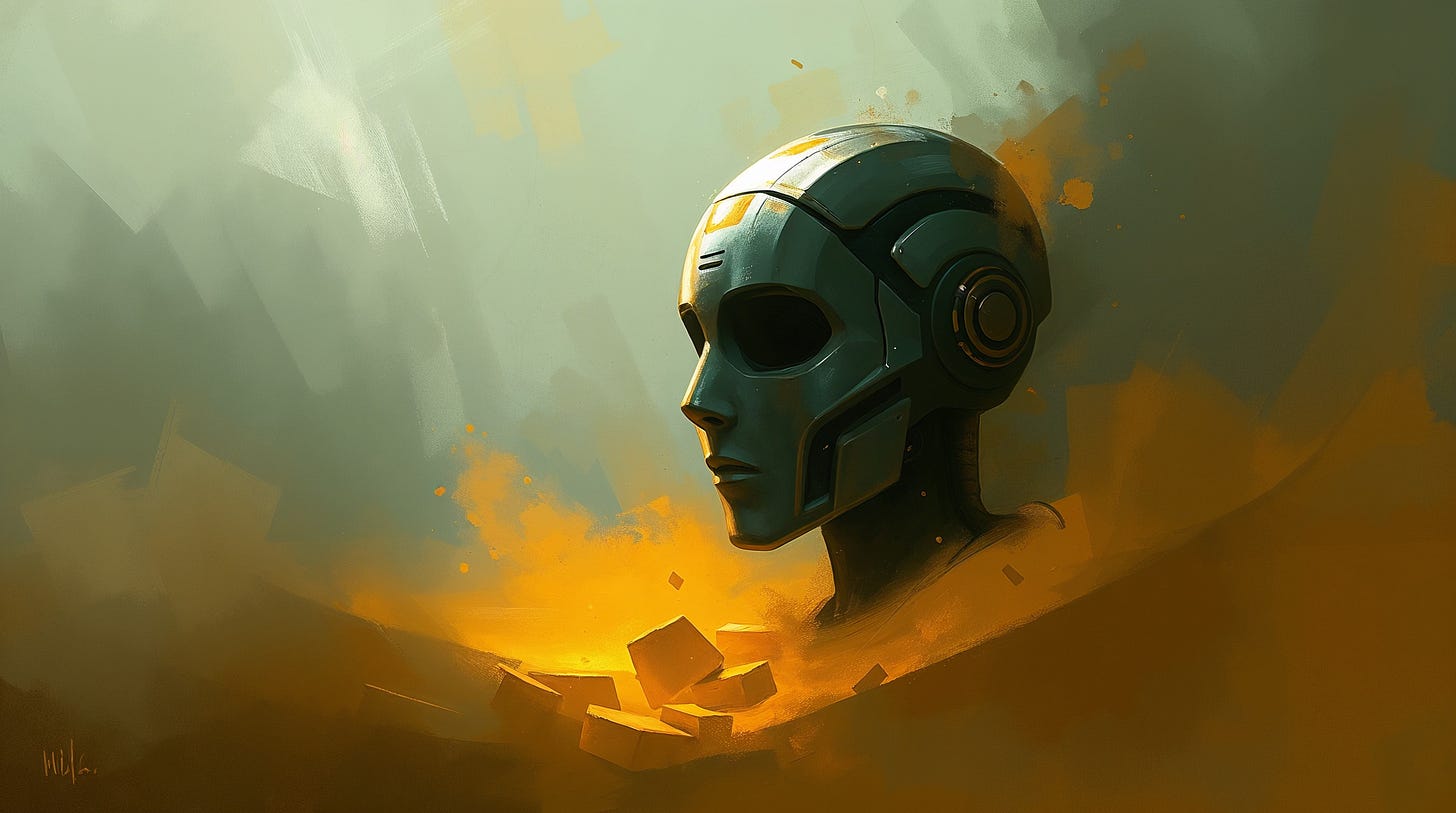Beyond the Tool: Why True AI Literacy is About Critical Thinking, Not Prompting
How to cultivate a critical, cultural, and human-centered approach to AI in the classroom.
The integration of artificial intelligence into our classrooms has ignited a fierce and often polarized debate. As educators, we find ourselves at the center of this discourse, navigating a landscape of exhilarating possibilities and profound concerns. On one side, proponents envision a future of personalized learning, automated support, and democratized knowledge that could level the educational playing field. On the other, critics voice deep-seated fears about the erosion of critical thinking, the rise of academic dishonesty, and the potential for AI to amplify societal biases, creating new forms of inequity.
This is not a debate about a new piece of software. It's a debate about the future of education itself.
I want to argue that the most productive path forward is to frame AI literacy not as a set of technical skills, but as a critical and cultural practice. This perspective shifts our focus from the mechanics of tool proficiency—like prompt engineering—to the cultivation of enduring intellectual habits: critical thinking, ethical reasoning, and sound judgment. From this vantage point, AI literacy isn't a new subject to be squeezed into our curriculum; it is a modern expression of our timeless goal as educators: to empower students to think for themselves, question the world around them, and make discerning choices about the powerful tools they encounter.
To make this case, we'll first explore how the very definition of "literacy" has always evolved with technology. We will then ground our discussion in the principles of critical literacy, which frame any literacy as a social and ideological practice. From there, we will analyze the current debate on AI literacy and, finally, propose concrete pedagogical strategies, including "unplugged" activities, that show how we can teach the core principles of AI literacy as an extension of fundamental thinking skills, without ever needing to log on.
Literacy Has Always Been More Than Just Reading
The debate over AI literacy is simply the latest chapter in a long story about the evolving meaning of "literacy" itself. The term has never been static; it has always expanded to reflect the competencies required for meaningful participation in society.
For millennia, literacy was simply the ability to read and write, a skill often restricted to a small elite and tied to religious or political power. The word "literacy" itself only appeared in the late 19th century, coinciding with the rise of mass public education.
The 20th century saw a crucial shift with the emergence of "functional literacy," defined by UNESCO as the ability to use reading and writing for the "effective function of his or her group and community". This moved the concept from an abstract skill to a set of applied competencies for navigating daily life. Scholars then began to frame literacy as a "social practice," arguing that reading and writing are never neutral activities but are always situated within specific cultural contexts.
Today, UNESCO defines literacy as a "continuum of learning" that includes digital skills, media literacy, and global citizenship, positioning it as a means of communication in an "increasingly digital, text-mediated, information-rich and fast-changing world". This has led to the identification of numerous "21st-century literacies" that are precursors to AI literacy:
Digital Literacy: The ability to use technology to find, evaluate, create, and communicate information.
Media Literacy: The ability to "access, analyze, evaluate, create, and act" using all forms of media, not just text.
Data Literacy: The ability to understand, analyze, and communicate with data, a foundational skill for understanding how AI operates.
This evolution from alphabetic recognition to a suite of critical competencies provides the essential context for the current debate over AI literacy.
The Critical Turn: Seeing Literacy as a Social Practice
To frame AI literacy as a cultural practice, we must engage with a deeper theoretical tradition: critical literacy. This perspective provides the tools to interrogate technology not as a neutral force, but as a product of complex social and power dynamics.
Critical literacy is a "central thinking skill" that involves the active questioning of ideas, moving beyond simply reporting on a text to analyzing and evaluating it. Rooted in the work of Brazilian educator Paulo Freire, critical literacy seeks to analyze the relationship between language and power. Its purpose is to uncover embedded discrimination and challenge the power structures related to race, gender, and class that are often invisibly encoded in texts and media.
The New Literacy Studies (NLS) framework challenges the "autonomous model" of literacy—the belief that literacy is a neutral, technical skill that automatically brings progress. In contrast, NLS proposes an "ideological model," which argues that literacy is always a social practice, embedded in specific cultural contexts and power relations.
When we apply these principles to technology, the implications are profound. Digital, media, and AI literacy cannot be seen as neutral skills. They are socio-technical systems "embedded with values, logics, and power structures". The narrative that AI will inherently improve education echoes the flawed "autonomous model". A critical approach, therefore, must move beyond "How do I use this tool?" to ask: "Who created this tool, and for what purpose?", "Whose values are embedded in its design?", and "Who benefits and who is harmed by its deployment?".
Locating AI Literacy: A New Tool or a New Way of Thinking?
The debate over how to teach AI literacy reflects the historical tension between functional skills and critical competency, with approaches falling along a spectrum.
At one end is the instrumental or digital literacy model, which frames AI literacy as the next logical step after digital and data literacy. This approach centers on proficiency with AI tools, aiming for effective and efficient use. Its primary goal is workforce readiness and task automation, with key skills including prompt engineering and using specific AI applications. From this perspective, AI is viewed as a neutral tool whose morality depends on the user, and the ethical focus is often narrowly defined by responsible use and avoiding plagiarism. The pedagogical goal is to teach students how to use AI.
At the other end of the spectrum, an emerging and more critical paradigm frames AI literacy as a fundamentally different kind of competency. This critical and cultural literacy model views AI not just as a tool, but as a complex socio-technical system that actively shapes culture, knowledge, and power. Its primary goal is to foster informed citizenship, ethical reasoning, and student agency. This approach recognizes the reciprocal relationship between AI and culture, where our values shape AI and AI, in turn, influences our cultural norms. It connects directly to social justice and critical pedagogy, empowering students to challenge how AI can reinforce racism, sexism, and other biases.
Consequently, the key skills are much broader, including bias detection, systems thinking, and epistemic judgment. AI is seen as an ideological artifact embedded with the values of its creators, and the ethical stance is systemic, addressing issues like data privacy, algorithmic bias, labor exploitation, and environmental impact. The pedagogical goal is not just to teach students how to use AI, but how and why to critique it, and—crucially—when not to use it.
This divergence shows that the debate over AI literacy is a proxy for a deeper conflict over the purpose of education. The instrumental approach aligns with a view of education as a pipeline for an AI-ready workforce. The critical and cultural approach aligns with a humanistic model focused on cultivating ethical and engaged citizens. The path we choose makes a powerful statement about our core educational philosophy.
The Heart of AI Literacy: Knowing When to Say No
If AI literacy is to be more than training on transient tools, it must be grounded in durable human capacities. The most significant challenges posed by AI are not technical; they are about our relationship with knowledge, our ability to think critically, and our capacity for sound judgment.
True literacy in any domain involves discretion. The pinnacle of AI literacy is the ability to make a conscious, critical decision about when not to use AI. This is not an act of technophobia but a reasoned choice. Reasons to forgo AI are numerous: concerns about data privacy, the risk of amplifying harmful biases, and the potential for generating "hallucinations". In our context as educators, the most compelling reason is pedagogical. We might choose to abstain from AI to prioritize the development of foundational human skills: the "desirable difficulty" of brainstorming, the cognitive work of structuring an argument, or the personal process of finding one's authentic voice.
Generative AI operates on probabilistic pattern-matching, not factual understanding. This leads to profound challenges. It can produce "hallucinations", plausible-sounding but entirely false statements, with complete confidence. It is already being used to generate "synthetic data" in academic research, creating risks of misrepresentation. Some scholars argue this necessitates an "adaptive epistemology," where the primary intellectual skill is not knowledge acquisition but epistemic judgment: the ability to critically evaluate the credibility, context, and limitations of all information, especially that produced by an AI.
AI and Critical Thinking: A Double-Edged Sword
The relationship between AI and critical thinking is complex. On one hand, AI can be used to foster critical thinking by providing diverse perspectives or acting as a Socratic partner to challenge a student's reasoning. On the other hand, over-reliance on AI can lead to the atrophy of these same skills, encouraging a passive acceptance of machine-generated content. This is the fear that we are offloading the uniquely human task of thinking onto machines.
Navigating this requires cultivating intellectual virtues: humility (recognizing AI's limits), courage (questioning AI's outputs), and curiosity (asking deeper questions). It is crucial to remember that AI itself cannot be virtuous; it is a non-conscious entity without moral agency. It can only exhibit "virtue-by-proxy," mimicking the ethical principles embedded by its human creators. This places the ultimate responsibility squarely back on our shoulders.
Teaching the Principles Without the Platform
If AI literacy is fundamentally about critical thinking, then its core principles can be taught effectively without ever using an AI tool. By focusing on the conceptual underpinnings of AI through "unplugged" activities, we can equip students with a durable skill set that transcends any specific technology.
"Unplugged" activities are playful, often physical, learning experiences that teach computational concepts without computers.
Teaching Classification: In the "Good-Monkey-Bad-Monkey" game, students develop rules to classify images, creating a physical decision tree that teaches the logic of AI classification models.87
Simulating Machine Learning: The "Monster Mapping" activity simulates a clustering algorithm by having students physically group monster cards based on shared features, learning how unsupervised machine learning identifies patterns.
Exploring Bias in LLMs: In "Large Language MadLibs," students use dice rolls to simulate how LLMs generate text based on word probabilities, demonstrating how biased data leads to biased outputs.
Engaging with Ethics: "Data Brokers" is a role-playing game where students act as companies using data to target users, sparking discussions about data monetization and surveillance.
These activities prove that the conceptual foundations of AI—algorithmic logic, the role of data, the emergence of bias—can be taught through tangible, interactive experiences.
Strengthening Foundational Literacies for the AI Era
The most effective preparation for a world with AI is to double down on foundational critical skills.
Advanced Source Evaluation: Traditional checklists like the C.R.A.A.P. test are insufficient for an AI-saturated landscape. We should instead teach more robust strategies like lateral reading, leaving a source to investigate its author and reputation elsewhere online, and the SIFT method (Stop, Investigate the source, Find better coverage, Trace claims to the original context).
Bias Detection in Media: Long-standing media literacy curricula provide a powerful foundation for understanding algorithmic bias. Lessons that teach students to analyze news sources for biased word choice, framing, and representation equip them with the lens needed to detect similar biases in AI-generated content. The core question of media literacy—"Who created this message and for what purpose?"—is precisely the core question of critical AI literacy.
Ethical Reasoning: Rather than being a niche topic, ethical reasoning should be integrated across the curriculum through project-based learning, scenario-based discussions, or by embedding ethics modules directly into technical courses.
When we do use AI tools, our pedagogy should center human agency, promote ruthless reflection on the tool's impact on our thinking, and use AI as a catalyst for deeper human inquiry.
AI Literacy as the New Humanism
A narrow, instrumentalist view of AI literacy—one focused only on using tools—is insufficient and potentially harmful. It risks producing compliant users of a technology they do not critically understand.
A more robust approach frames AI literacy as a critical and cultural practice. It recognizes that the core challenges of AI are not technical but humanistic: challenges of epistemology, ethics, and judgment. The most vital competencies are the abilities to critically evaluate information, discern truth from falsehood, understand how power is embedded in technology, and decide when not to delegate human cognition to a machine.
This reframing leads to a powerful conclusion: the most effective way to teach AI literacy is to strengthen the core of a humanistic education. The skills are not new. They are the timeless skills of critical thinking, close reading, and ethical reasoning. By teaching students how to analyze texts of all kinds (including algorithmic outputs) and question power structures (including those encoded in software), we equip them with a form of literacy that is truly future-proof.
Ultimately, the goal of AI literacy should not be to make students better at using AI, but to empower them to be more discerning thinkers, more ethical citizens, and more self-aware human beings in a world where AI exists. It is a call to reaffirm that the purpose of education is not to train operators for today's machines, but to cultivate the critical and creative minds needed to build a more just and thoughtful world tomorrow.





Absolutely! As someone in the critical media literacy world, the word "critical" has made all the difference in our field. Who has power in media dynamics, why does that matter? All these questions help us to be more ethical producers and consumers. It's great to see this work happening in the AI space too.
I like the article! My main counterpoint is about framing it as critical thinking, as I wrote recently.
https://timdasey.substack.com/p/teach-judgment-not-critical-thinking